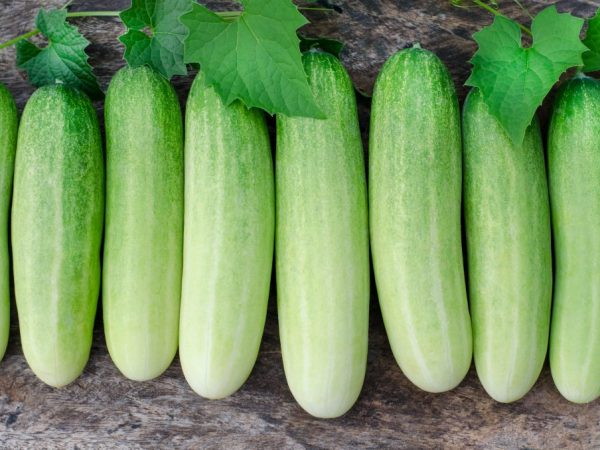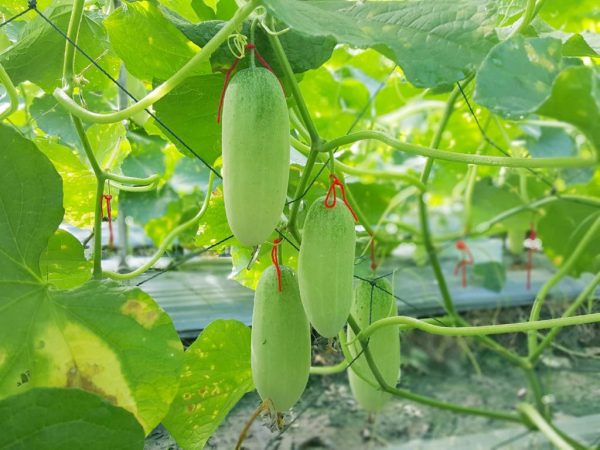Characteristics of the White Angel cucumber variety
The White Angel cucumber variety is perfect for lovers of delicious juicy vegetables. The fruits of the variety differ in color: they are light green, almost white. It is the appearance that attracts gardeners.

Characteristics of the White Angel cucumber variety
Cucumber Care White Angel is no different from the traditional one. Timely watering, adherence to temperature conditions, regular feeding are the main procedures. Another advantage of the variety is its high yield.
Characteristics of the variety
White Angel is a hybrid mid-season variety. It should take 50-55 days from germination to fruiting. Basically, cultivation is carried out in the open field, but it is permissible to plant in a greenhouse or other enclosed space. The main thing is to comply with sanitary standards and often carry out cleaning.
According to the description on the package, the White Angel variety of table cucumbers has the following characteristics:
- excellent taste;
- yield 12-15 kg per 1 sq. m;
- fruits that do not spoil during transportation;
- resistance to changes in climatic and weather conditions, but it is better to maintain the recommended parameters.
The variety has a high level of parthenocarp, that is, there is no need for pollination for setting.
Description of the bush
Bushes are indeterminate. The growth of the central whip is unlimited. Many lateral shoots are formed on the stem. The type of flowering is mixed, but the flowers of the female type prevail.
The optimum planting density is 3 plants per 1 sq. m. If there are more bushes, they do not grow well. Subsequently, the yield level may decrease.
Leaves are slightly wrinkled, of medium size, have a rich dark green color. The edges of the leaves are irregular.
Up to 2 ovaries are formed in 1 node. Up to 20 cucumbers, or 4 kg, are harvested from one bush.
Description of fruits
The main value of White Angel cucumbers is an unusual color. Due to their light green, almost white skin color, they stand out from other varieties.
Brief description of the fruits:
- medium lumpy;
- almost absent pubescence;
- soft skin;
- white, thornless thorns;
- small seeds;
- cylindrical, elongated shape.
The average weight of one cucumber of the f1 hybrid is 100 g. Its length does not exceed 10 cm, diameter is 3 cm. The pulp is loose and sweetish, but often has a slight bitterness. The aroma is intense and pleasant.
The cucumbers are crispy and sweet, great for fresh consumption. For conservation, it is better to choose a different variety. The white angel is often added to cold and warm salads, used as vegetable slices.
Care
Plant care is required traditional. It consists of a number of procedures:
- weeding;
- topping;
- watering;
- top dressing.
Before planting, the seeds are soaked in a solution of potassium permanganate for 2 hours. Such processing is needed to protect the grains from pests. It is also important to remember to fertilize the soil. Before transplanting seedlings or planting seeds, the ground is moistened and a small layer of mullein is placed.

It is important to maintain an optimal temperature
It is extremely important to observe the temperature regime.If the cucumbers are grown in a greenhouse, the optimum temperature during planting is 22 ° C. During the growing season, it cannot be lower than 25 ° C, otherwise the male type of flowers will prevail. The main disadvantage is that fruits do not form on them.
Weeding
Another important procedure is loosening. It is carried out when the soil is covered with a small dense crust. The purpose of weeding is to allow oxygen to flow to the root system of the bush. This stimulates its growth.
Loosening helps prevent weeds. They are removed so that they do not harm the roots.
Topping
Grasshopping is necessary for the rapid development of the bush. It is important to prune old shoots to form new and young ones. This makes it possible to get more high-quality harvest.
If the bush bears fruit actively, there is no need for pinching.
Top dressing
Needed to enhance plant growth. Another purpose of the exercise is to improve the quality of the fruit. For hybrid cucumbers, gardeners recommend considering a complex of organic and mineral fertilizers.
Among the minerals, nitrophoska is the best. It is a mixture of several components:
- nitrogen affects the germination of crops and seedlings;
- phosphorus makes cucumbers dense, juicy, and crispy skin;
- potassium is responsible for excellent taste.
Mullein, bird droppings are used as organic ones. During planting, a solution of mullein and sulfate is introduced. Need 1 tsp. sulfate, 500 ml mullein and a bucket of water. All are mixed and allowed to brew for 2 hours. For 1 sq. m is enough for 5-6 liters of solution.
Watering
The basic rule is to use only settled warm water. Watering is carried out daily in summer, especially during drought. In the rains, the bed is watered when the ground becomes dry.
Water should only fall on the ground near the root. Leaves and fruits cannot be watered, it is allowed to spray them with warm water only once a week.
An insufficient amount of watering negatively affects the fruits. They become bitter and soft, deformation is possible.
Diseases and pests
The main drawback of the variety is its poor resistance to diseases, but if the care is organized correctly, the probability of infection is very low.
Before planting, the greenhouse or field is inspected for ants. These are the main carriers of aphids, which are quite problematic to remove. The main method of struggle is to pour kerosene into the nest.
The leaves are regularly wiped off with a damp cloth. If the soil is waterlogged, root rot may appear. It will spoil the root system, as a result, the fruits will be small and inedible.
A number of pests may be negatively affected:
- brown spotting;
- olive spot;
- mosaic virus;
- powdery mildew;
- cladosporium disease;
- sclerotinia;
- whitefly.
It is necessary to deal with them immediately after detection, because they have the ability to quickly spread to other plants.
Conclusion
Cucumber White Angel is a great solution for gardeners who love unusual plants. Light color, delicate skin, juicy pulp are the main advantages of the culture. Despite the weak resistance to pests, cucumbers tolerate temperature changes well.


